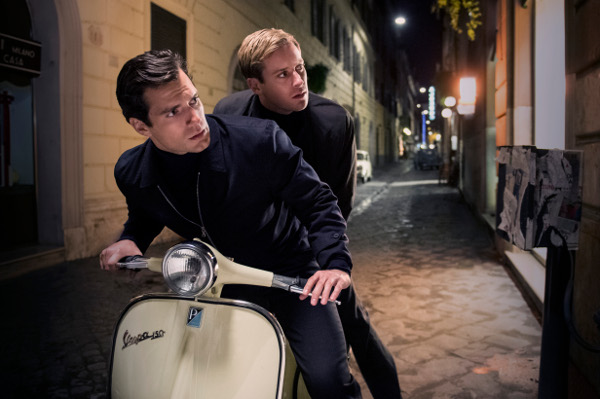
THE MAN FROM U.N.C.L.E. captures retro style in reboot of ’60s TV spy series
– FILM REVIEW – By Cate Marquis –
Director Guy Ritchie (“Snatch,” “Sherlock Holmes”) delivers a stylish bit of ’60s spy film fun with “The Man From U.N.C.L.E.,” an elegant, entertaining reboot of the 1960s James Bond-style spy TV show. Rather than updating the TV series to the present as many others have done (think “Mission: Impossible”), Ritchie keeps “The Man From U.N.C.L.E.” in the Cold War 1960s. The result is a classy, beautifully photographed spy thriller/spoof packed with vintage ’60s style – not the Mike Myers bad-teeth-and-loud-clothes version of the era but the elegant Sean Connery 007 James Bond version – with color-block mod fashions, mid-century modern settings, retro gadgets, race cars and a sun-drenched Italian coastline.
The film is a lot of fun, a great way to wrap up the summer, a stylish spy film romp packed with references to ’60s thrillers, and filled with gorgeous period costumes and settings, plus wonderful jazz-flavored music. Clearly, Ritchie both knows and loves this film genre and its era. The downside is that much of this rich cinematic and historical detail may be lost on younger viewers, who never saw the original show, are unfamiliar with the Cold War or may not even know what the Berlin Wall was.
The film is set in Cold War 1960s. CIA spy Napoleon Solo (Henry Cavill) is sent to the Russian side of the Berlin Wall to smuggle out Gaby Teller (Alicia Vikander), the daughter of a missing former Nazi nuclear scientist, who the Americans fear is helping build a secret nuclear bomb, with hopes she can help locate him. But what seemed like a simple extraction becomes something wildly complicated when KGB spy Illya Kuryakin (Armie Hammer) shows up to stop them. Solo does finally get her out, but only to learn that the CIA and KGB are temporarily setting aside their Cold War hostilities because the threat of a nuclear bomb in unknown hands is a great enough threat that they need to work together. Against their wishes, Solo and Kuryakin find teamed up, along with the resourceful, clever Teller, for a mission, where among their foes is the rich, glamorous crime-syndicate leader Victoria Vinciguerra (Elizabeth Debicki).
The Cold War was such an integral part of the TV show, which ran from 1964-1968 but much of the appeal of the slick, very popular program depended on its charismatic characters. American Napoleon Solo (played by a suave Robert Vaughn) and Russian Illya Kuryakin (played by a cool David McCallum) were spies working for the international United Network Command for Law and Enforcement (U.N.C.L.E.), to thwart the international criminals of T.H.R.U.S.H. Part of the show’s thrill was that it crossed the Cold War lines separating the capitalist U.S. and the communist Soviet Union, but the show also packed a sexy, James Bond-ish elegance (with Bond creator Ian Fleming as an early adviser).
The movie reboot keeps some of the ’60s original but Ritchie and co-writer Lionel Wigram (the director’s “Sherlock Holmes” collaborator), made some changes. The TV show’s Solo was a smooth, never-ruffled cosmopolitan but in the movie, Cavill’s Solo is a well-dressed ex-thief prone to a bit too much over-confidence. The show’s Kuryakin was a slim, coolly-reserved, technical wizard, while Hammer’s character is described as a Russian “giant” with impressive physical abilities and an anger management problem. A better update is the addition of the Teller character to the team, a brainy female mechanic who is a formidable force in her own right rather than a damsel to be rescued or pretty decorative “Bond Girl.”
Fans of ’60s thrillers will delight in this well-made, visually-polished film, with cinematography by John Mathieson (“Gladiator”). The film’s pacing and visual style recreates the era in many ways, employing techniques of the era such as split screens to recreating the feel of the era. Ritchie also skips the continual quick-cutting style to which most modern audiences are accustomed, except in the action sequences, which employ some cinematic tricks and clever effects to enhance the action.
The story uses a number of plot set pieces from the ’60s era (or plays around with them, as when Solo calmly sips wine while observing Kuryakin’s frantic speedboat chase). Fans of the genre will get these references but unfortunately, they may do nothing for other audience members. One of the film’s best action sequences comes early on, a breathless wild ride as Solo is trying to get Teller out of Soviet-controlled East Berlin while being relentlessly pursued by Kuryakin. There are other chases – through narrow European streets, in a speed boat, in dune buggies above a rocky coastline. One scene with an ex-Nazi torture expert (a deliciously creepy Sylvester Groth), has some wicked dark humor but might put off some audience members.
While the film is an exercise in polished, top-notch visual style, where it falls a bit short is on the chemistry between the two lead characters. Cavill and Hammer bring individual charm to their roles but the double entendres and comedic bickering dialog Ritchie and Wigram employed so effectively in “Sherlock Holmes” does not seem to work with Cavill and Hammer. Vikander does fine in her role, but really is not given enough to do. Supporting roles are nicely acted, with Debicki is terrific as the villainous Victoria, and Groth wonderfully evil as the mentally-twisted torturer, but other supporting characters seem underdeveloped. Despite all its retro style, the film feels mostly like an origin story for an action flick franchise.
Whether “The Man From UNCLE” will click with younger audiences will depend on how much they know (or are willing to learn) of its time period and genre. Given the success of “Mad Men,” it might happen. Meanwhile, fans of 1960s spy thrillers, and fine cinematography, can enjoy a stylish retro ride with “The Man From U.N.C.L.E.”
© Cate Marquis
